The Tunnel at the Niagara Parks Power Station offers a captivating blend of history, engineering marvel, and breathtaking views, making it a must-visit destination for both history enthusiasts and photographers. We visited in 2022 shortly after the tunnel opened and were impressed with the design and scope of the new attraction, spending hours poring over historic views and machinery, getting soaked by the mist of the falls, and capturing memorable photos.
Niagara Parks Power Station & Tunnel
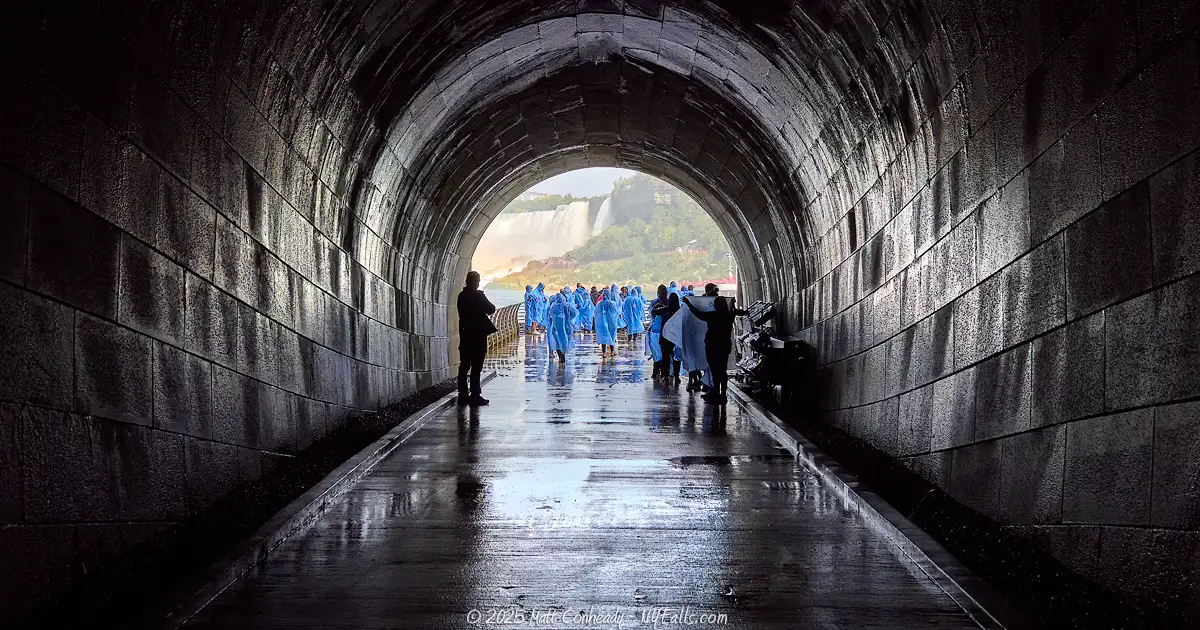
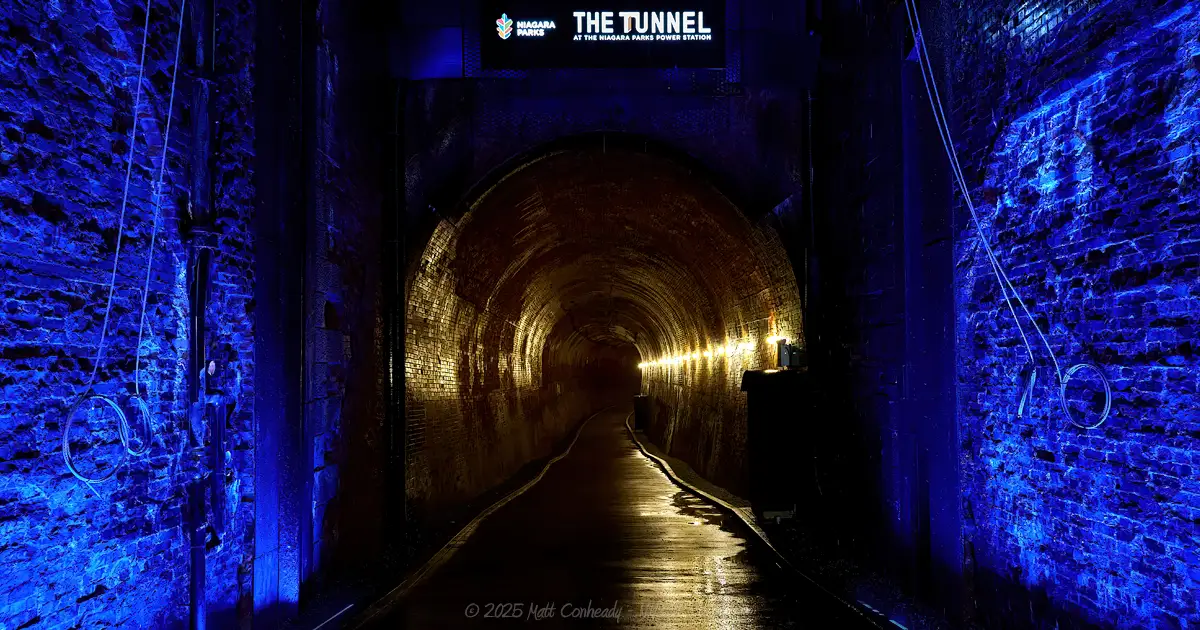
Location
Situated at 7005 Niagara Parkway, Niagara Falls, Ontario, Canada, the Niagara Parks Power Station stands as a testament to early 20th-century industrial architecture. Nestled near the iconic Horseshoe Falls, just south of Table Rock, the station provides visitors with unparalleled access to the gorge below the Horseshoe Falls.
Parking is conveniently available at Falls Parking Lot A, but if you are parked elsewhere it’s a brief walk upstream from the Falls.
Hours & Admission
Admission to the Niagara Parks Power Station encompasses comprehensive access with a few different ways to experience it:
- General Admission: Grants access to the main generator floor, interactive exhibits, and the Tunnel experience with breathtaking views of the falls from river-level. CAD $32 adults / $21 children. Children under 2 are free.
- Guided Tours: For an additional fee, visitors can partake in guided tours led by knowledgeable interpreters, offering deeper insights into the station’s history and operations. CAD $42 adults / $27 children. Children under 2 are free.
- Power Station at Night: Currents Light Show: Evening visitors can enjoy “Currents: Niagara’s Power Transformed,” an immersive sound and light show that brings the power station to life. Tickets are sold at the same rate as general admission.
Tickets can be purchased both online and on-site. The Niagara Parks Wonder Pass provides access to 5 attractions, including this one, for a low price: CAD $49 adults / $32 children, which is not much higher than admission to this attraction alone. We highly recommend considering this deal, especially if you plan on staying at the falls for more than one day.
Hours: The attraction is open 7 days a week from March through December. From 10 am to 5 or 6 pm, depending on season. Power Station at Night begins at those close times and runs until 7 or 8 pm in the off-season and 10:30 pm during peak season.

Walkthrough of the Experience
Exterior
Approaching the power station, visitors are greeted by its Romanesque architectural design, characterized by arched windows and a rusticated stone exterior. The building’s low-profile design and dark green roof were intentionally chosen to blend seamlessly with the natural surroundings of the Niagara River.
Main Generator Floor
Upon entering, the expansive generator hall unfolds, showcasing restored turbines and generators, painted in bright blue, that once powered the region. Various restored equipment, with brass dials, analog meters, and copper switches are staged throughout, but do not create a sense of clutter. Informational signage and labels are provided for those eager to learn what all this stuff does. While the plant was upgraded and operational into the 2000s, in its restored state it does feel frozen in time in the early 1900s. There are wonderful learning and photographic opportunities in every corner.
Interactive exhibits and informative panels provide insights into the engineering feats and historical narratives of the station’s operational years. Visitors can explore:
- Scale Models: Detailed representations of the plant’s machinery and operations.
- Life-Size Penstock Walkthrough: An opportunity to walk through a replica of the large pipes that channeled water to the turbines.
- Interactive Control Panels: Hands-on exhibits allowing visitors to simulate managing the power generation process.
The generator floor is massive and takes at least 30 minutes minimum to explore. Restrooms and a gift shop are located through one of the blue floodgates on the river side.
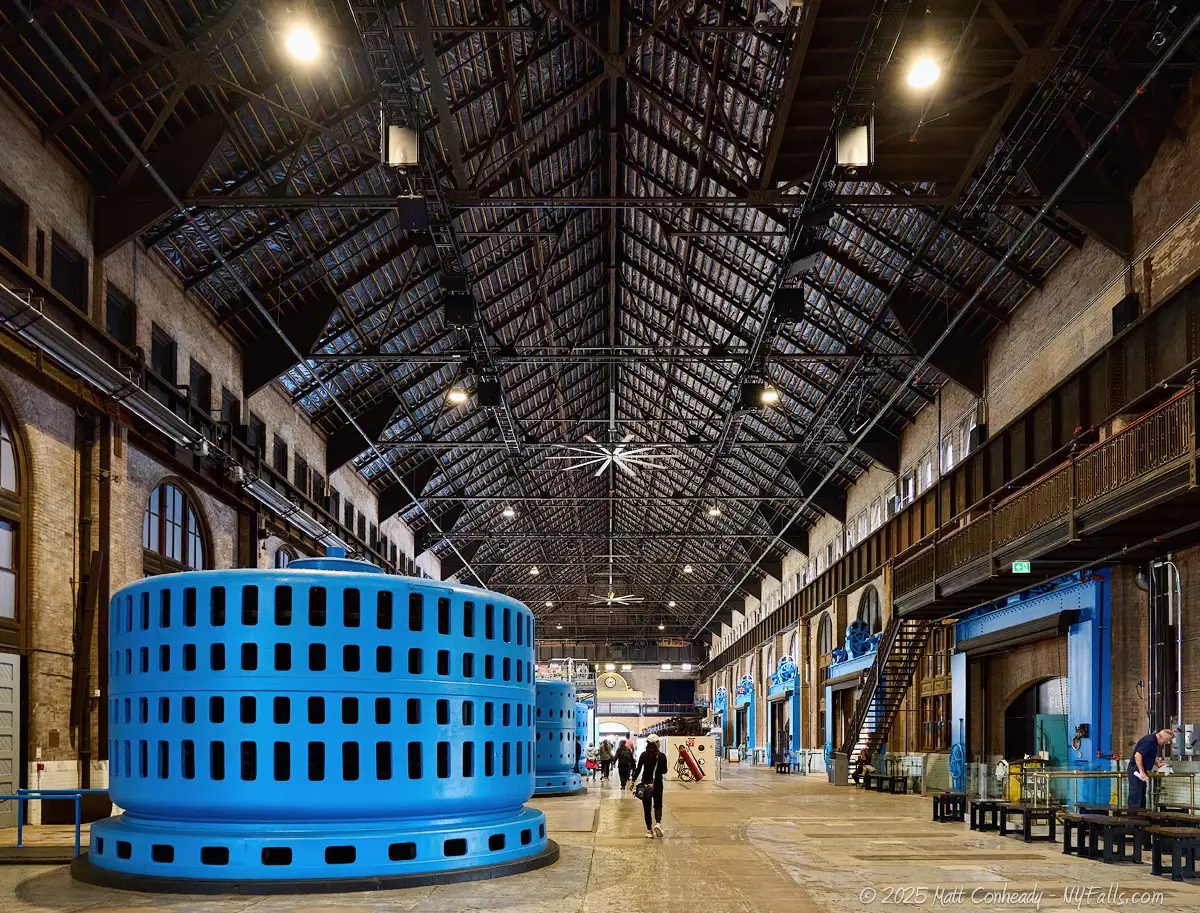
Elevator Descent
Located near the entrance, a glass-paneled elevator offers a descent of 180 feet, dark and eerily illuminated, it provides a unique perspective of the station’s internal structures and leading to the underground tunnel.
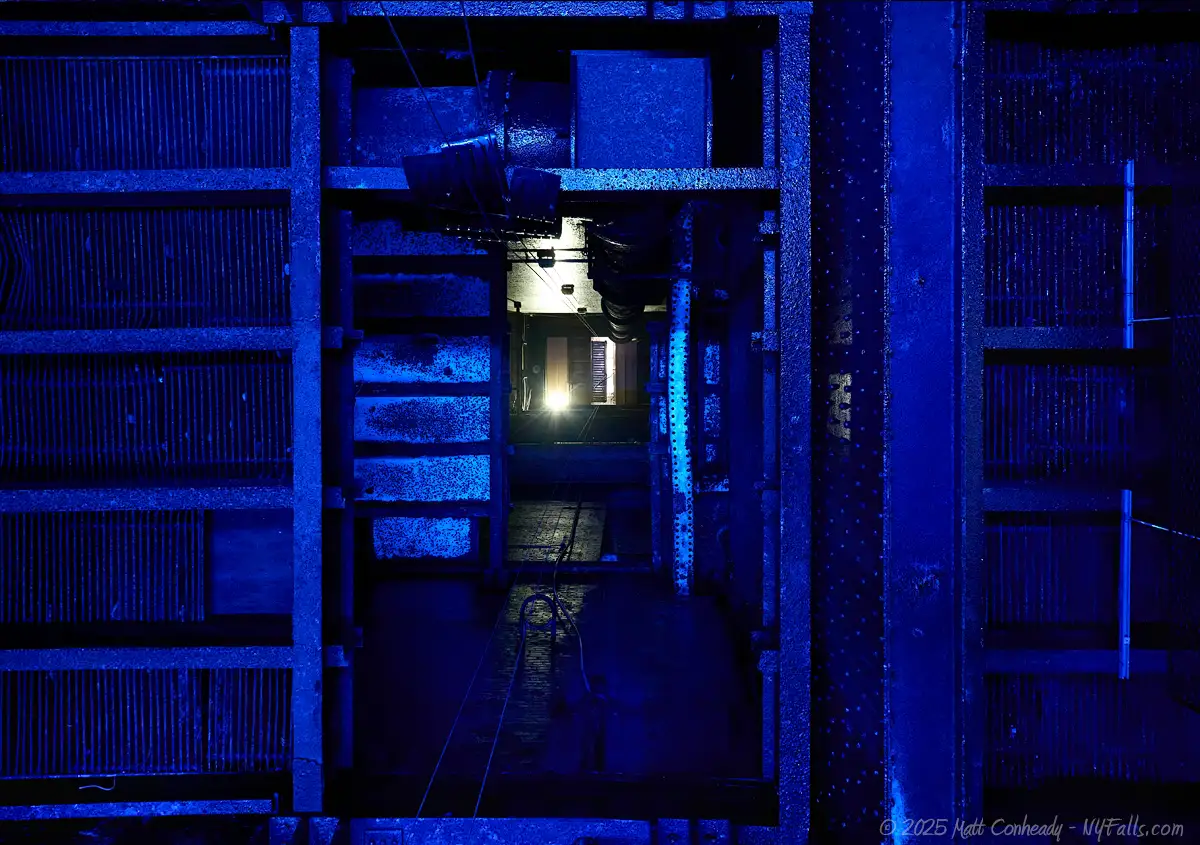
The Tunnel
It’s just an old tunnel, right? I was absolutely thinking this would be a pretty dull walk, but as soon as the elevator door opened, I was caught in a blue-lit, brick-lined room opening to a warmly lit tunnel, almost like we were transported to another world. Stretching 2,200 feet, the tunnel served as the tailrace, channeling spent water from the turbines back into the Niagara River, now mostly dry, and converted to a pretty level (and accessible) walkway.
Along the walk, which can take 15 minutes or more, visitors can observe the meticulously laid original brickwork that has withstood the test of time, lit by ambient lighting that highlights the tunnel’s architectural features and creates a moody atmosphere. There are informational displays that detail the construction techniques and challenges faced during the tunnel’s creation complete with illustrations and photos of the construction. QR codes on each sign, I assume were intended to allow folks to scan and read while they walk, but within the runnel, cell phone reception isn’t great if you can get it at all.
Because the tunnel is underground and a little damp, it’s colder than conditions up at the surface. If the weather that day is borderline jacket-weather, you may want to bring one for this.

Observation Deck
At the end, the literal light at the end of the tunnel can be seen. It opens up to a concrete observation platform at the river’s edge, just below Table Rock. Similar to the observation platform within the Journey Behind the Falls attraction, you will get wet from the mist of Horseshoe Falls to the right (free rain ponchos are available at the platform). While this view is a bit further from the Falls compared to Journey’s platform, it’s closer to water level and the angle allows you to see more of the Horseshoe Falls. This vantage point provides a unique perspective and panoramic view of the river with both waterfalls in clear view. Take all the time you want, and return via the tunnel and elevator.

Loved it!
The Tunnel at the Niagara Parks Power Station offers something truly special—an immersive blend of history, engineering, and awe-inspiring natural beauty. As someone who’s visited countless Niagara Falls attractions, I found this experience to be refreshingly unique. It gave me some of the best views of the falls, second only to the Maid of the Mist or Niagara City Cruises, but with the added depth of exploring the infrastructure that once powered the region. Walking through the very tunnel that carried water beneath the falls over a century ago, surrounded by original brickwork and the roar of distant rapids, felt like stepping into the past.
More than just a scenic detour, this attraction tells a story—of industry, innovation, and revitalization. Repurposing a long-dormant power station into a modern historical experience is exactly the kind of creative tourism we need more of. I’ll definitely return, and I highly recommend it to anyone who appreciates architecture, history, or just wants to see Niagara Falls from a refreshing new perspective.

Power Station History
Cedar Island
Long before hydroelectric turbines churned beneath the Niagara River, the land where the power station now stands held a much humbler role. Known as Cedar Island, this modest two-acre landmass stood near the Canadian shoreline just above Horseshoe Falls. In the mid-1800s, Samuel Street leased the island and built a house crowned with a 50-foot wooden observation tower known as “Street’s Pagoda”—a rustic viewing platform for tourists eager to witness the natural might of the falls.
However, the land itself was fleeting. By the turn of the century, the island had eroded so significantly that it was deemed suitable for infill. In 1901, as industrialists raced to harness Niagara’s hydraulic power, Cedar Island was permanently absorbed into the mainland during the construction of the Canadian Niagara Power Company’s new generating station.
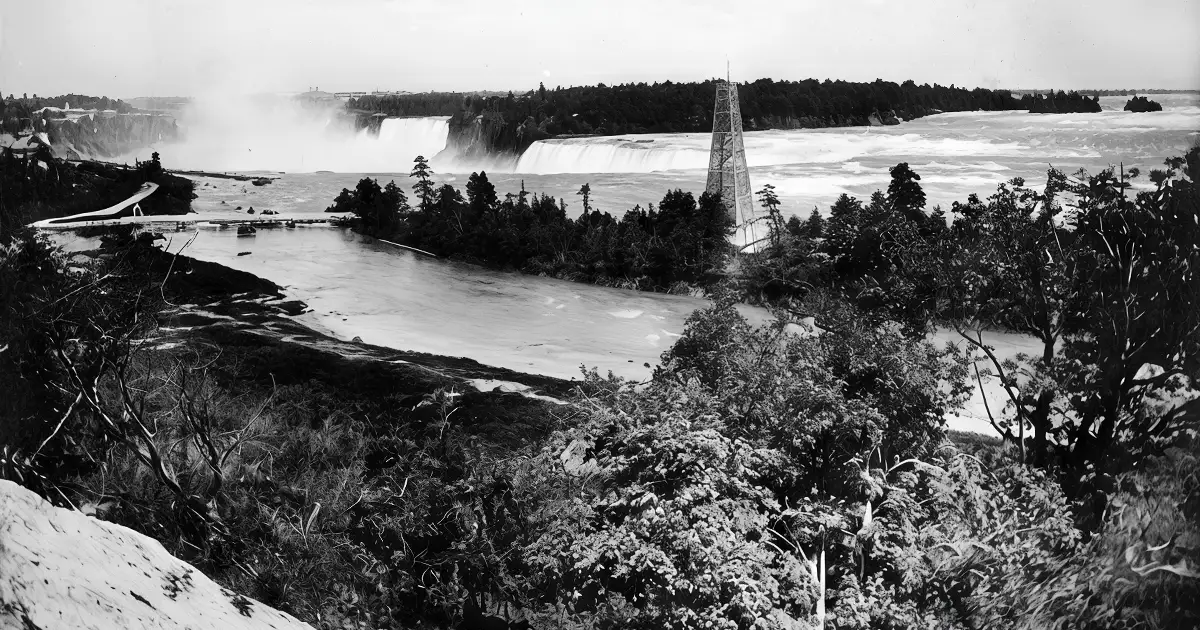
The Birth of the Canadian Niagara Power Company (1901–1905)
Chartered in 1892 and led by visionary engineer William Birch Rankine, the Canadian Niagara Power Company (CNPC) sought to tap the immense energy potential of Niagara Falls. Construction of the power station began in earnest in 1901, and it became a marvel of Edwardian engineering.
Completed in 1905, the William B. Rankine Generating Station featured a 175-foot (6-story) vertical drop to channel water to through turbines to the tailrace tunnel—a staggering descent achieved through giant penstocks that fed water into the heart of the powerhouse. Inside, 11 massive Westinghouse generators were installed to convert that mechanical force into usable electricity.
A Westinghouse Excitation Control Regulator, like this one preserved in the station today, was used to “raise” or “lower” excitation (applying current to the electromagnets) of a generator. This rotary controller, paired with the synchronous generators, allowed engineers to fine-tune voltage levels before sending electricity outward—initially to the town of Niagara Falls and later as far away as Buffalo, NY.

Engineering Elegance & Operator Precision
The architecture and control systems inside the plant reflect a remarkable blend of functionality and grace, a good case study for infrastructure design of the time. The interior walls—lined with pale glazed brick—were not merely aesthetic; they made surfaces easier to clean and brightened the workspace with reflected light. Equipment like analog gauges, voltage regulators, rotary converters, and multi-pole switches gave operators direct, manual control over the flow of electricity. These instruments are critical historical artifacts, often custom-built and robustly encased in polished brass or iron. Much of this equipment is preserved in the station today and it makes for wonderful photography subjects.
These weren’t simple flip-switches and barely anything was automated. The central control gallery was staffed by trained engineers who used this bank of analog instruments to maintain load balance, monitor turbine performance, and protect the system from power surges or mechanical failures.
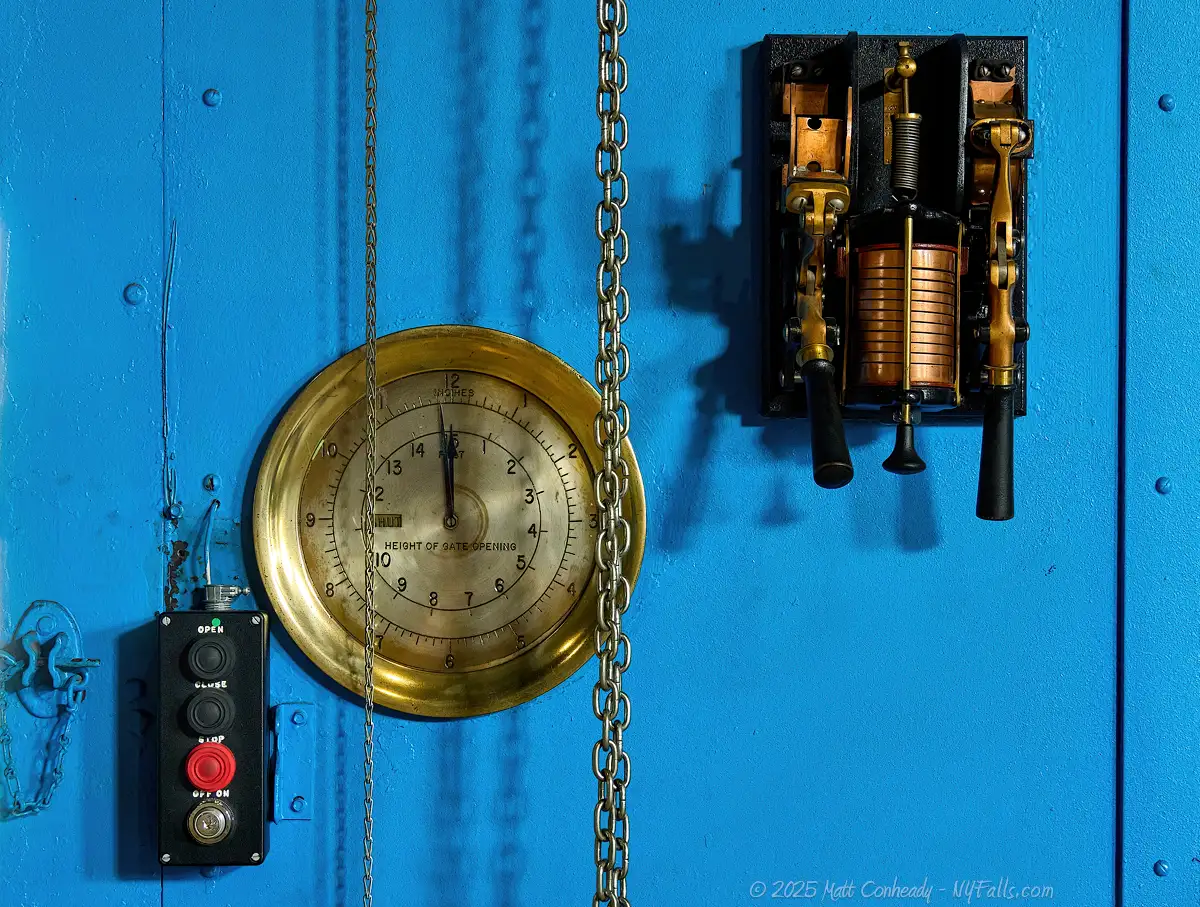
Decades of Continuous Operation
From 1905 through 2006, the power station continuously fed electricity to Ontario and New York. It remained operational far longer than many contemporary hydro plants, thanks to its rugged design and careful maintenance. Over the decades, equipment was upgraded, but the station retained much of its original form—a testament to the quality of its construction and the enduring power of water-driven energy.
Over the years the plant was referred to by several names, including the shortened “Rankine Generating Station” and the “Canadian Niagara Power Generating Station.”
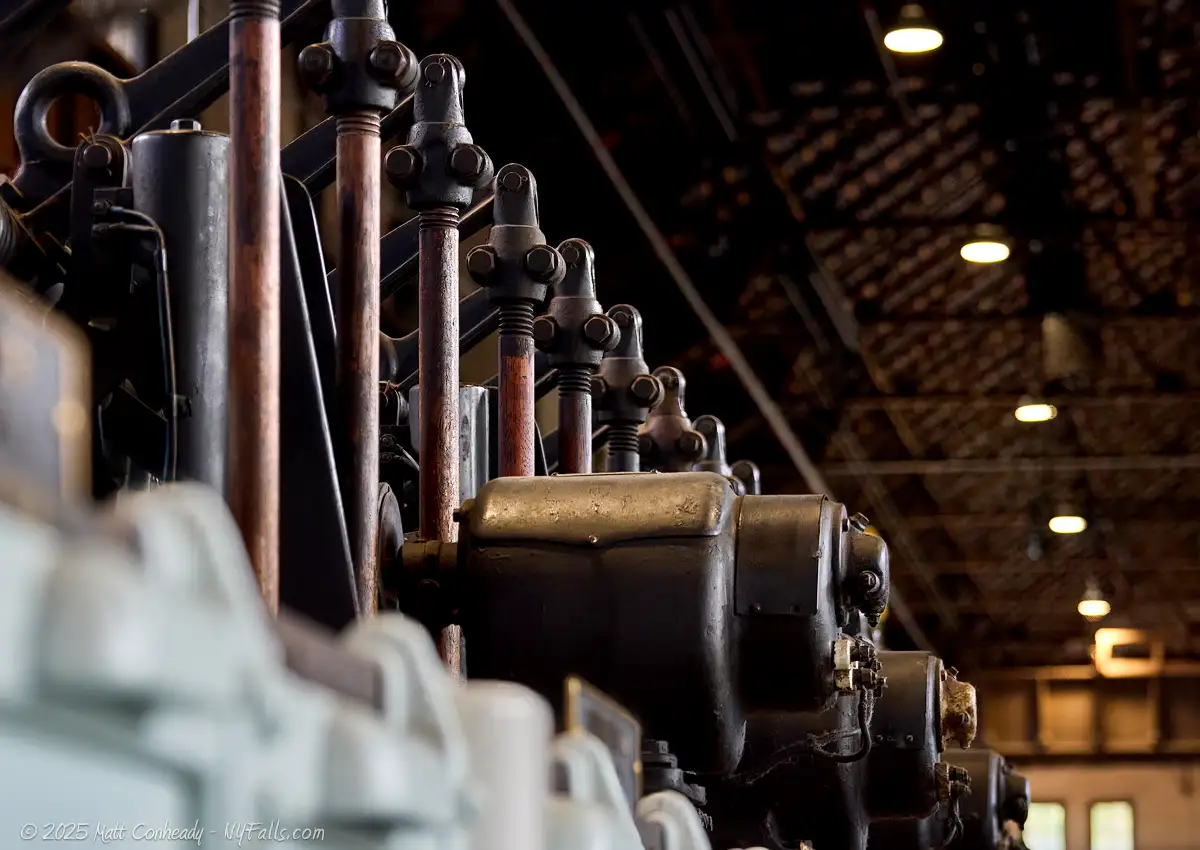
Decommissioning & Preservation (2006–2021)
After more than a century of service, the CNPC station was retired in 2006. Several factors contributed to the decision to decommission the plant. Aging infrastructure was the key factor, as despite upgrades, it could not come close to competing with modern plants in capacity, efficiency, automation, and safety. Rather than allow it to fall into decay, the Niagara Parks Commission embarked on a massive restoration and adaptive reuse project.
Over 15 years, the station was carefully cleaned up, restored, and reimagined as a historical and immersive attraction. Old electrical panels were polished and labeled for interpretation. The machinery was preserved, and lighting was added to dramatize key engineering features. The tailrace tunnel—once a functional outflow for used water—was excavated, illuminated, and adapted for foot traffic, allowing visitors to trace the path water once took to return to the river.
The power station reopened to the public in 2021 as the Niagara Parks Power Station, with the tunnel portion debuting in July 2022.
Tunnel History
A Hidden Artery Beneath the Falls
Beneath the grandeur of the Niagara Parks Power Station lies one of its most remarkable engineering feats: the 2,200-foot-long tailrace tunnel. Built more than a century ago, this tunnel once served as the final leg in the power station’s energy conversion process, quietly discharging millions of gallons of used water back into the Niagara River after it had spun the station’s massive turbines.
Today, that same tunnel is a core part of the visitor experience as a walkway to a spectacular viewing platform—but its origins trace back to a monumental effort in industrial-age ingenuity.
Purpose of the Tailrace Tunnel
In hydroelectric generation, once water from the river is directed through penstocks (giant pipes) and used to turn the turbines, it needs to exit the system and return to the river. That’s the role of the tailrace—a channel designed to carry “spent” water away from the plant without disrupting operations.
At the Niagara Parks Power Station, this tailrace took the form of an enormous underground tunnel, dug through bedrock, and sloped downward to allow gravity to carry the water out beneath the falls.

Construction Begins: 1901–1905
The tunnel was constructed concurrently with the rest of the power station between 1901 and 1905, and it represents one of the most physically challenging parts of the entire project. To achieve its final form, workers excavated nearly half a mile (670 meters) of solid Queenston shale and limestone, much of it done by hand or with rudimentary steam-powered equipment and explosives.
Workers and Conditions
Labor was carried out largely by Irish, Italian, and Eastern European immigrants who, using hand drills, pickaxes, shovels, basic mining machines, and explosives, toiled in dangerous, cramped conditions underground with minimal ventilation and constant threats of rockfalls, dust, flooding, and toxic fumes. Despite the risks, progress moved steadily thanks to round-the-clock shifts, and by the time the station was ready to open in 1905, the tailrace tunnel was complete and fully operational.
Engineering Design and Function
The tunnel was engineered with an oval-shaped cross-section, roughly 7 meters (23 feet) high, to maximize water flow efficiency while maintaining structural stability. The tunnel sloped gently downward from the turbines to an outlet hidden below the Horseshoe Falls, allowing for consistent gravitational flow; its brick-lined walls, reinforced with concrete and stone, were built to withstand constant moisture and pressure, while a strategically placed pondage beneath the plant cached large torrents of water to prevent backflow and flooding, enabling the tunnel to quietly discharge millions of gallons per hour back into the river.
Dormancy and Rediscovery
After the plant ceased operations in 2006, the tunnel was sealed and fell into dormancy. It wasn’t until the Niagara Parks Commission began planning the site’s transformation into a visitor attraction that serious work began on reclaiming the tunnel. This involved excavation and stabilization of old structural supports, installation of lighting and safety features, and creation of a modern elevator shaft to connect the generator hall above with the tunnel below.
One of the biggest challenges was making the tailrace safe and accessible while preserving its historical integrity—ensuring that guests today walk the same path as the water did, without altering the tunnel’s original function or form. Along the way, the tunnel is dotted with informational signage providing insight into its design, construction, and use.

Niagara Falls Visitors Guide
Filled with facts and figures, tips, photos, and profiles of parks and main attractions, our guide to Niagara Falls shows you all the amazing stuff the region has to offer, while leaving out the gaudy tourist traps.





